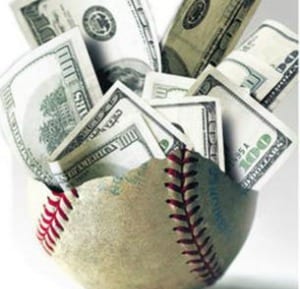Money Flows to MLB, but There is Debt in Baseball
There’s no debt in baseball.
The season just started and no matter where you look, the sport is gushing money like a BP oil well. Consider these figures:
$14.2 billion: Amount of baseball’s latest TV contract. If you’re doing the revenue sharing, that’s $52 million per team, per year for the next eight years.
100 percent: The increase ESPN, Fox and Turner Networks paid to be part of that eight-year deal. That’s twice as much as they paid for the previous contract. Who wouldn’t pay double to watch something as slow, drawn-out and sleep-inducing as baseball?
1,525 percent: The increase in revenue enjoyed by MLBAM, which took in $650 million in 2012. Some analysts estimate its total value at $6 billion to watch and read about baseball. Unbelievable!
Yankees Are Baseball’s Richest
$744 million: Average value of a major league team. The Yankees, naturally, are worth the most at $2.3 billion and yes, I do mean a billion with a “B.”
23 percent: The jump in value for all MLB teams over the past year. By comparison, the U.S. economy improved an average of 2 percent last year. Clearly the economy is not moving slow enough.
$3.14 billion: Estimated payroll for the 30 major league teams on Opening Day. The Yankees ($229 million) and Dodgers ($216 million) are spending the most.
5.9 percent: This is the increase in average player salary over the past year. The average ballplayer makes $3.6 million. The minimum salary is $480,000. Yes, that how much you can make to stand in the sun and occasionally move if a ball is hit your way.
Let’s pause with the numbers game for a moment. If you want to go back over those figures and gush a little, please do. They left me dumbfounded. Now back to the numbers.
The 2 percent of the population who say trite things like “baseball is a game of numbers” will tell you that the figures above aren’t really what the game is about. Those people worship acronyms like ERA, WHIP, WAR and RAT, which are supposed to be the real measurements of the game, though nobody really knows what they mean.
There is an acronym for the few people who do. It’s DORK.
If you are a non-DORK, you probably wonder what there is to complain with the game of baseball. The sport is flush. It’s rolling in the one acronym everyone understands — $$$$ — and the forecast for the future is continuing showers of cash.
Are Overpaid Stars Worth It?
Baseball’s top-paid players make obscene amounts of money for doing next-to-nothing. Yes, that’s the definition of virtually every baseball player, but the guys who tens of millions are really doing next-to-nothing for the money. And there are LOTS of them. There are 103 players making more than $10 million a season. Forty-five of them make more than $15 million and 21 of them make more than $20 million.
In return, you get Yankee slugger Mark Teixeira batting .250 for $23 million. Or Giants’ pitcher Tim Linecum giving up 5.18 runs a game for $22.3 million. Or Yankees center fielder Vernon Wells stealing $24.6 million for hitting 11 home runs in a season.
Those three, and plenty more like them, are proof there is debt in baseball, though you have to go strictly by the Webster’s Dictionary definition — something that is owed or that one is bound to pay to or perform for another — to call these guys actual debtors. They owe fans a lot more than they’re giving and here is a postion-by-position at baseball’s biggest debtors.
Position by Position All-Debt Team
On the mound is New York Mets’ lefty Johan Santana, the easiest choice for this team. He made 21 appearances last year and was paid $24 million, or $1.14 million every time he showed up for work. How can you top that? Santana can! He’s due $25 million this year, but hasn’t thrown a pitch yet and may not throw one all season because of shoulder injury. That would mean $25 million for NOT showing up to work.
It’s probably a good thing Santana can’t pitch because there really are no debtors to catch him. Teams are getting what they pay for from catchers. The only outrageous salary belongs to Joe Mauer of the Twins, who gets $23 million a year to hit .319. Mauer could have more home runs (10) and RBIs (85), but generally speaking, he produces for his team.
First base is another story. Teixeira would seem to be a lock, until you look at Philadelphia’s Ryan Howard , who does even less for $20 million. Howard played 71 games and batted .219 last season. With bad wheels, he could easily be worse. And next year, he gets $25 million!
Second base is a one-man show. Atlanta’s Dan Uggla hit .220 last year, a point better than Howard, and he only got paid $13 million. The good news is he was consistently bad, playing in 154 games. The bad news, for Braves fans anyway, is that he’s still got two years and $26 million left after this season.
Shortstop was difficult call. The Dodgers’ Hanley Ramirez hit 24 home runs and had 92 RBIs, but he doesn’t cover much ground and his .257 batting average isn’t worth the $15.5 million he gets this year and next.
Third base is easy. Yankee bank-vault Alex Rodriguez is going to win this spot for at least four more years. That’s how long he has left on the outrageous 10-year, $275 million deal he signed in 2008. He made $29 million for playing 122 games last season. He might play half that many this season, but he only get $28 million for it. His power numbers (34 HRs over the past two seasons) have dived since people became aware of his steroid use and he doesn’t cover much ground at third base anymore, but there is good news Yankee fans: He’s only got four years and $86 million left on his deal.
Left field is L.A. Dodger Carl Crawford, who got $19.5 million to play 31 games last season. He had surgery on his elbow last summer, rendering a weak throwing arm all but useless this year when he gets $20 million. Only four years and $80 million left on his deal, after that.
Wells woeful stats make him an untouchable liability in center field. The good news for Yankees fans is there is only one year left on his contract and it’s only $21 million.
Another Dodger, Andre Eithier, is the only right fielder we could come up with and that’s mostly because he’s going to get $85 million over the next five years for mediocre stats, a .284 batting average with 20 home runs.
So there you have it, nine bad-to-horrible contracts that prove one thing: We’d all be out of debt, if we could only play baseball!








